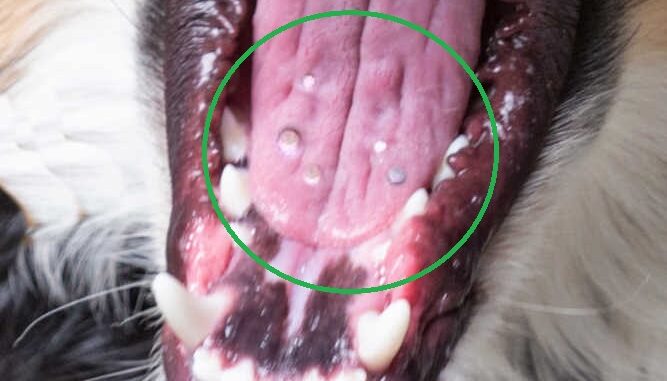
This article was updated on January 14th, 2024
There are many different conditions that can cause white spots or bumps on a dog’s tongue, some minor and others more serious. As a veterinarian, I inspect dogs’ mouths and tongues daily and frequently talk to owners about these concerns. In this article, I will explain the top causes and provide guidance on what to do next.
Let’s review the most likely causes so that you know what you may be up against!
7 causes of white spots or bumps on dog tongue
1. Papillomavirus white spots (warts)
Typical appearance and clinical signs
Papillomas are warty growths that are caused by a virus known as canine papillomavirus. These growths most commonly occur in clusters in and around the mouth. They appear as small, firm, pale/white irregular growths and are often described as having a cauliflower-like appearance.
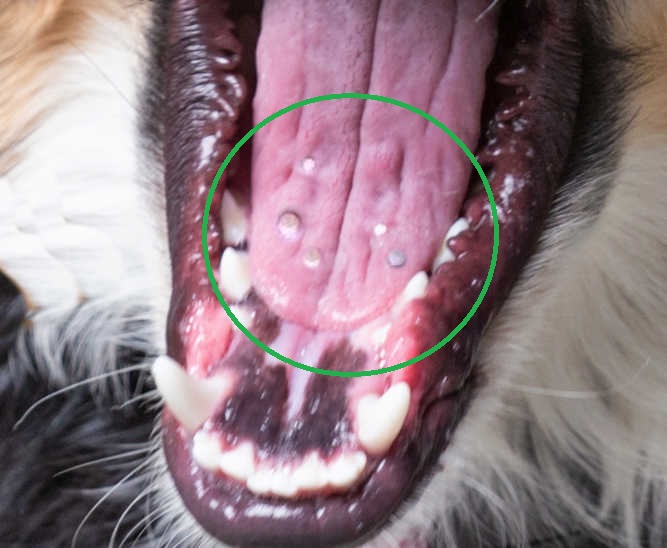
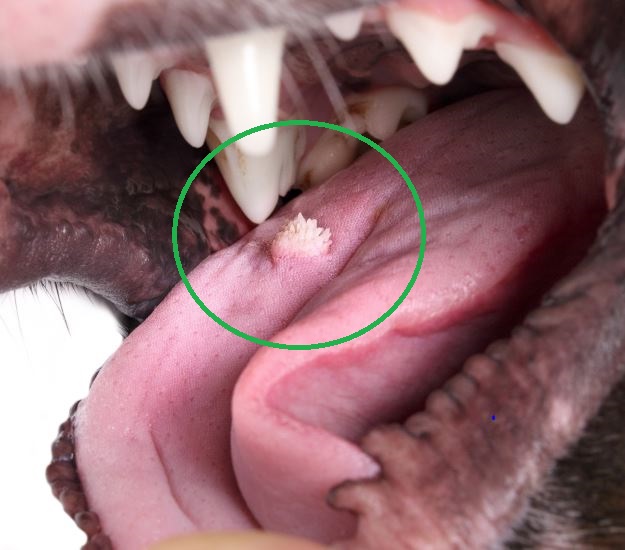
The virus is spread by direct contact with an infected dog or with contaminated objects such as toys, bedding, or food bowls. Infection tends to occur if the skin is injured and the immune system is immature or suppressed.
As a result, papillomavirus commonly infects puppies or young dogs, especially if they frequent dog parks or daycare. While this virus is contagious among dogs, it cannot be spread to people or other animals.
Diagnosis and treatment
As these warts tend to have a typical appearance, your vet may be able to identify them on visual inspection alone, or recommend additional testing such as fine needle aspirate and cytology. In most cases, lesions will usually go away on their own within one to two months.
If they have not resolved after three months, or if the lesions are numerous and interfering with eating or drinking, then treatment is recommended. Treatment may involve surgical removal or cryotherapy. In some cases, the immune system can be stimulated by crushing some of the warts or removing them to make a specific vaccine. Additionally, these warts can become infected with bacteria from the mouth, requiring antibiotics such as Azithromycin.
Prognosis
While these warty growths may have a concerning appearance, they are benign and the prognosis is excellent. However, due to the contagious nature of this condition, it is important to keep your dog away from other dogs until the lesions are gone.
2. Benign or cancerous mass
Below is an example of a white mass on a dog’s tongue that would requires veterinary workup to determine type, treatment, and prognosis:
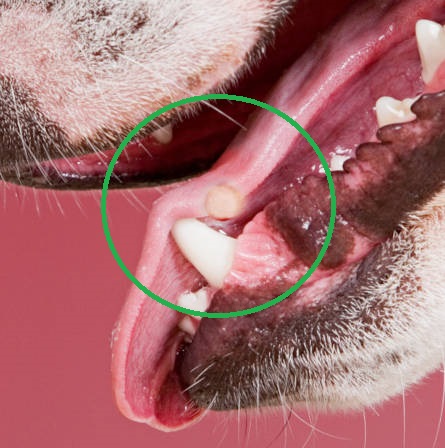
Typical appearance and clinical signs
Dogs can get masses anywhere on their body, including in the mouth or on the tongue. In fact, oral cancer is the fourth most common malignancy in dogs and cats. There are many different types of cancer that can occur in the mouth, some of which are slow growing and benign, while others are fast-growing with the potential to damage other structures in the mouth and metastasize to other areas of the body.
Clinical signs of oral tumors may vary depending on the type, size, and location of the mass, but often include a visible mass, mouth pain, drooling, difficulty eating, swelling, bleeding from the mouth, and halitosis (bad breath). Several breeds seem to be more predisposed to oral cancers, including Boxers, Chow Chows, German Shepherds, German Shorthaired Pointers, Golden Retrievers, Gordon Setters, Miniature Poodles, and Weimaraners.
Diagnosis and treatment
The type of mass is diagnosed based on tissue sampling, either from a fine needle aspirate or biopsy. If there is a concern for malignant cancer, a full body workup known as staging is indicated to look for any evidence that cancer has spread. This typically involves bloodwork, chest X-rays, abdominal ultrasound, and lymph node sampling.
Treatment is generally surgical removal, however, this can be difficult if the tumor has spread or invaded the bone. Your vet may refer you to a veterinary oncologist for advanced imaging, surgery, and additional treatments (such as chemotherapy and radiation).
Common types of oral masses
There are numerous types of oral masses that can occur in dogs that could be both malignant or benign. Examples of malignant (cancerous) masses include:
- Squamous cell carcinoma – Of all the oral masses in dogs, this is a common one and perhaps the most likely to be associated with the tongue. This website has several helpful pictures of squamous cell carcinoma under a cat’s tongue: AnimalDentalSpecialist.com.
- Malignant melanoma
- Fibrosarcoma
On the other hand, benign (abnormal but noncancerous) masses may be:
- Peripheral odontogenic fibromas – These firm masses arising from gingival tissue are slow growing but can become quite large.
- Papilloma – These contagious warty growths are caused by a virus and may regress on their own.
- Canine acanthomatous ameloblastoma – Although considered benign, this tumor grows fast and can invade local tissues, including bone.
Prognosis
The prognosis is directly related to the type of mass present. Dogs with benign masses that are surgically removed should have no ill effects on lifespan or quality of life. However, animals with aggressive malignant cancer may only live weeks to months after diagnosis. For this reason, early detection and treatment is key.
3. Calcium deposits
Image showing the appearance of calcium deposits on the tongue:
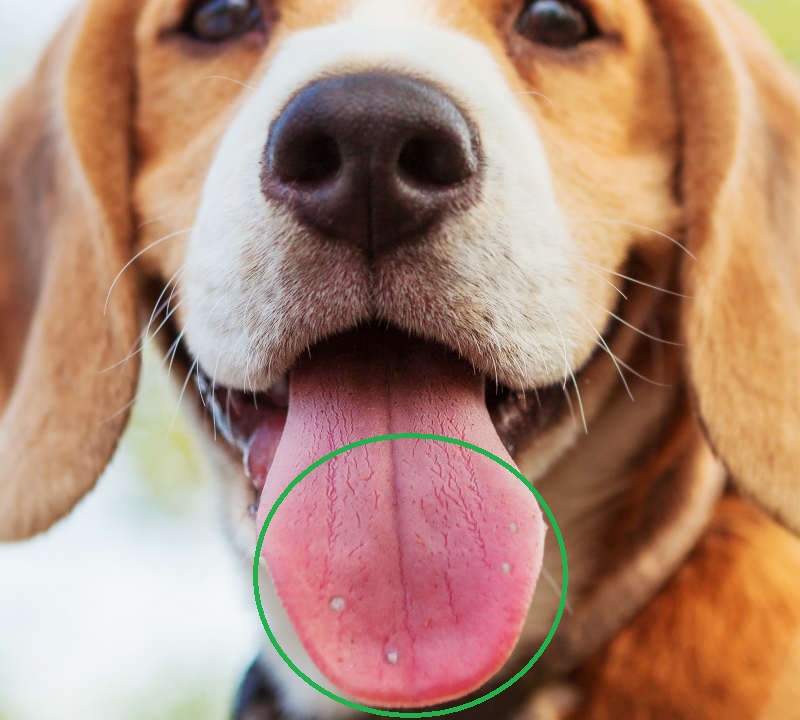
Calcium deposits can occur in the mouth or elsewhere in the skin. Calcinosis circumscripta may occur on the tongue, and commonly appears as firm white bump(s). This condition may be hereditary or a result of trauma to the area.
Small deposits may resolve on their own or can be cured with surgery. In some cases, especially in older animals, calcium deposits may be due to an underlying disease affecting calcium levels in the blood.
4. Dental disease
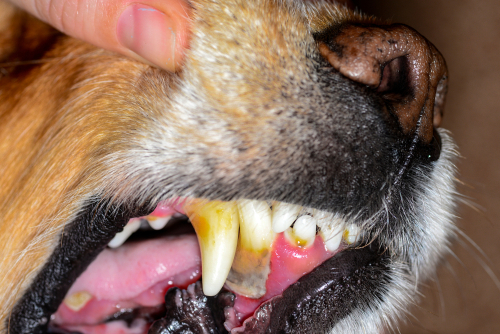
Periodontal disease is extremely common and affects the structures surrounding a dog’s teeth, leading to inflammation, bone loss, infection, loose teeth, and systemic infection if left untreated.
Dental disease can also lead to other changes in the mouth, such as tooth root abscesses, gingival hyperplasia, ulcers, and stomatitis. Clinical signs may range from asymptomatic to difficulty eating, halitosis, drooling, swelling, bleeding, and mouth pain. Treatment involves a thorough oral exam, teeth cleaning, dental X-rays, and possible teeth extractions, all performed under anesthesia.
The best way to keep your dog’s teeth and gums healthy is at-home dental care, including daily teeth brushing.
5. Ulcer or injury
Below is an image of tongue ulcers after contact with bleach:
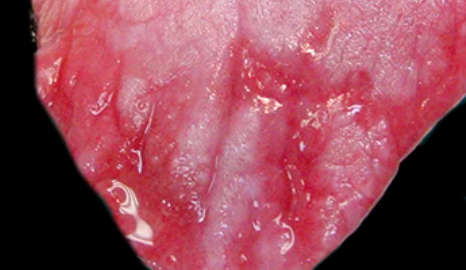
Dogs can develop ulcers or injuries on their tongue, lips, and gums as a result of dental disease, systemic diseases such as kidney disease, laceration, foreign body, electrical or chemical burns, and more.
Your vet will need to perform a thorough physical exam and workup to determine and treat the underlying cause. Along with mouth pain, drooling, and reluctance to eat, you may notice additional signs of the underlying illness. Ulcers may appear as red or white-coated sores or erosions in the mouth.
6. Infection or inflammation on tongue
Glossitis is the term for inflammation of the tongue. It can occur as a result of injury, infection, foreign body, or trauma to the tongue. Additionally, fungal diseases such as thrush can cause a white coating on the tongue.
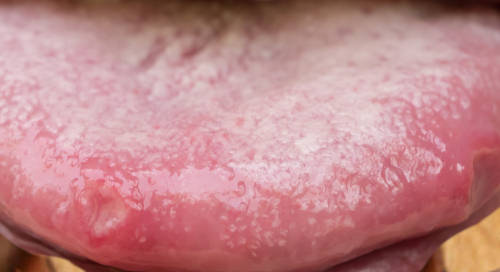
7. Anemia
If your dog has a decreased number of red blood cells, they can develop anemia. Anemia causes gums and tongue to appear pale pink or white. It can occur for a variety of reasons, including blood loss due to trauma or internal bleeding, or secondary to a systemic disease such as kidney disease or cancer. If your dog is severely anemic, they will also show other clinical signs including lethargy and weakness.
Below is an image showing pale / white gums on a dog due to severe anemia:
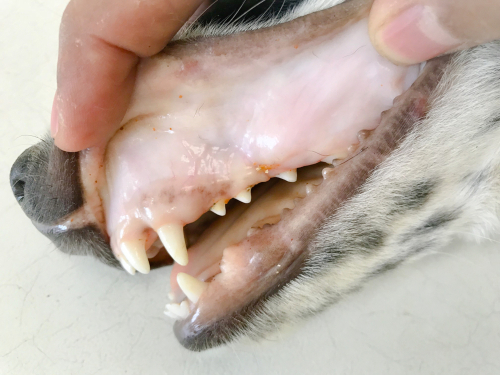
Treatment will depend on the underlying issue, with severely anemic pets also requiring hospitalization and blood transfusion.
When white bumps on a dog’s tongue are a reason for concern
A white spot or bump on a dog’s tongue may be due to a variety of factors, and without a thorough vet assessment, it is difficult to determine its cause and severity. In general, if you notice any changes in your dog’s mouth, it is best to get them checked out as soon as possible.
While it may be something minor or easily treatable, such as papillomavirus or dental disease, masses in the mouth can also be cancerous or a sign of a more severe disease. If this is the case, it is best to evaluate and treat them before they continue to grow bigger and cause more problems for your pup.
In most cases, it is impossible for your vet to determine what a white spot or bump may be just by looking at it. As a veterinarian, I often end up collecting a sample of cells for a fine needle aspirate or performing a biopsy to remove part or all of the area. These tests help diagnose the issue and determine the right next steps for your dog.
Can these white spots be a sign of cancer?
Dogs can get cancerous tumors all over their body, including in the mouth. While many are benign, others can be a sign of cancer. It is best to see your vet for a thorough exam and diagnostic testing as soon as possible. As mentioned, there is no way for a vet to determine what a white spot or bump may be just by looking. Therefore, collecting a sample of cells, either with a fine needle aspirate or biopsy to remove part or all of the area, is generally recommended.
Keeping up with annual vet exams and at-home dental care (such as daily brushing) are the best ways to identify concerning changes in your dog’s mouth as early as possible.
Disclaimer: This website's content is not a substitute for veterinary care. Always consult with your veterinarian for healthcare decisions. Read More.


Be the first to comment